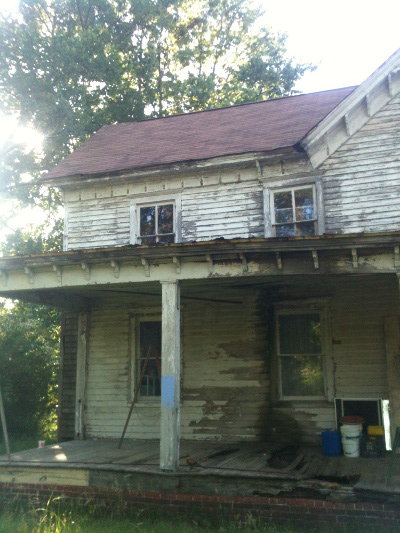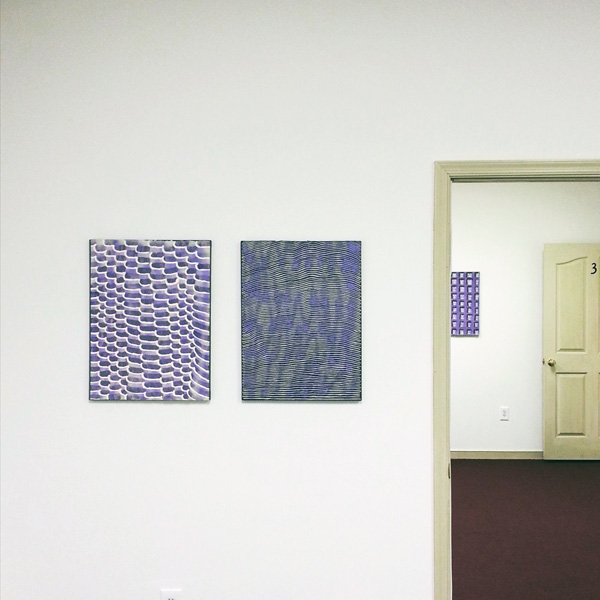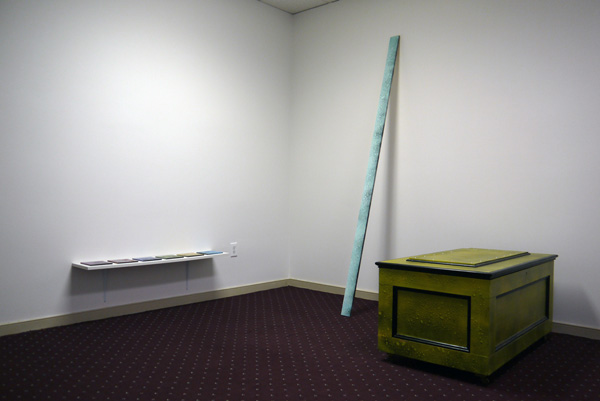
In Mathews, a small town located on�the�Chesapeake Bay in�Virginia, Justin Hunter Allen and Lucy Kirkman Allen run�a small gallery that they call�#FFFHEX, after the hexadecimal�designation for�white. Although they live in a rural area, they�graduated from�Cooper Union, have had a gallery space in Dallas, and�subscribe to what they call�”the�white cube philosophy” that art should be presented in a way that’s free from�distraction. When I received some promotional materials for the gallery and their small press a few weeks ago, I was curious about their projects and what it is like living in such an isolated area. I�contacted Lucy�via email and we had the following exchange.


Sharon Butler: I took a look at your website and learned that you graduated from�Cooper Union, lived in Dallas for a while, and then, after a spell, you and�Justin (your husband) moved to Mathews, Virginia, to help your grandfather. What are you helping with? Can you fill in the gaps on how you ended up there? How long are you planning to stay?
Lucy Kirkman Allen: My grandfather, V. B. Bandjunis, loved living in his home, Four Winds, on the tip of Virginia’s Middle Peninsula. He was very independent, even after a serious stroke in 2003, but my mother worried about him as a widower living alone. Justin and I had been burning a lot of�midnight�oil in the Dallas artist-run gallery scene with�Studio DTFU�and�SCAB. When she asked if we’d move into Serendipity, the cottage next door, it seemed like a good time for a change of pace and scenery. My grandfather and I played a lot of cribbage together, and I helped out with driving and errands. Sadly, he�died in July 2016.
Mathews is a fishing and farming community on the Chesapeake Bay with 8,000 people and zero stoplights. It’s restorative to see stars at night and be near the water. We love gardening, raising chickens, and putting out our crab pots. We want to stay here.
SB: What are�#FFFHEX�and�Airplane�Projects, and�AirPrint Press, and how did they get started? What do you hope to accomplish with these projects?
LKA: �When we left the Dallas and its galleries, ours peers, and all the ongoing conversations, Justin and I were�inspired by Spanish moss.�It lives in trees, without roots, and takes its nourishment from the air. We started The Airplant Project website to explore a new kind of sustenance for our art practices. The mission statement reads:
The Airplant Project is a think tank dedicated to the investigation of the artist’s professional practice physically estranged from a greater community and the development of intermediary communities for the expansion and reunification of a dialogue known as ‘the state of the contemporary arts.’
We found a 140-year-old farmhouse, where we rent a studio room, and christened it “Serendipity: Williams House” (S:WH). Our book�Fox�started as a natural working arrangement and we decided to make a show of it. S:WH is on a back road that is sometimes underwater, and with the holes in the porch, we didn’t think we could safely invite the public here. It’s a tree-falling-in-the-forest situation, thus the documentation-as-exhibition. We reached out to friends and mentors and invited them to do a project in the space or contribute writing. This became a series of eight books, Serendipity: Williams House 2014-2016. Our contributors are Michael Corris, Richard Bailey, Michael Dorsch, Travis Iurato, Joe Allen, Philip Hinge, V. B. Bandjunis, Cynthia Bandjunis, Eli Walker, Kelly Kroener, Makiko Nagaya, and Peter Lewis.

Justin and I first made exhibition catalogues to document projects in Dallas at Studio DTFU. We loved making books and valued having tangible records of the shows, but found we were lucky to break even on the cost of printing. Airprint Press, dedicated to free access to its published books, was conceived to keep overhead costs low while maximizing distribution. You can read the books online, or download files to print your own copy. Airprint Press encourages sharing of our books for non-commercial purposes.
#FFFHEX�is more of a traditional white-cube gallery, with a curatorial perspective that’s unique in Mathews. Justin was looking for a space suitable for public receptions, and we found one in the local county courthouse. To date, we’ve presented four exhibitions of paintings, sculptures, and prints, as well as the S:WH book series release.

SB:�I think you are both painters.�Can you tell me a little about your own work?
LKA: I’m working in egg tempera. Recently I’ve been drawn to traditional painting motifs: the equestrian painting, the floral still life, the hunter’s still life (literally�nature morte). For some time I was working with facsimilies/trompe l’oeil�painting, especially imagery from art paper ephemera (e.g. stamps, postcards, book pages). Painting from life now is skipping that layer of remove and more directly engaging the world, though still rooted in my love of art history.
In�Correspondence, contributor Richard Bailey wrote to Justin, “Just as [Gertrude] Stein believed poetry protects language from serving any master, Justin it seems that you believe art protects symbolic thinking about objects from serving any master. Your work exhorts the viewer to trust and embrace peripheral and subversive points of view.” Justin’s recent works are very formal, tangled calligraphic marks on raw un-stretched linen, or on canvases distressed one way or another�blasted by shotgun, for example. I see them like runes�found artifacts of some indecipherable language that my gut reads as votive/ritual objects.

SB:�How is the art community down there? Have you met any other artists with a similar vision? Is there a regional art scene? If yes, what’s it like? What kind of work are the local artists making?
LKA: Our peninsula has many artists and craftspeople, though very little conversation about contemporary art. Periodically I drive a few hours to Richmond or Hampton Roads to visit the museums and galleries, but we are pretty geographically isolated. There are some real diamonds here, though. In May #FFFHEX is showing figurative work by father-and-son painters Jack Banks and Hunter Banks, from nearby Wake. There’s a secretive folk artist, JCC, who makes amazing assemblages out on his marsh-island getaway, and we’re still hoping he’ll permit us to show his work.
SB:�Do you have regular jobs to help support your�projects? If yes, what do you do?
LKA: Justin works at the Port Haywood M&M Building Supply in the lumberyard. I’m lucky to be focusing on painting right now, although I was recently working in the children’s wing at the Mathews Memorial Library.
SB: Thanks, Lucy, for taking the time to answer my questions. Good luck with your projects.
“Serendipity: Williams House 2014-2016” Book Series Release, AirPrint Press, part of the Airplant Project. All books available online for free. �Books include:�Correspondence�texts by Michael Corris, Richard Bailey, Michael Dorsch /�fox�works by Justin Hunter Allen, Lucy Kirkman Allen /�Eagle or Hawk�text and works by Travis Iurato /�Twilight time�text and works by Joe Allen /�Fullmoon Mysticism�text and works by Philip Hinge /�4 Winds�text by V. B. Bandjunis, works by Cynthia Bandjunis /�Royal Waves�works by Kelly Kroener, Eli Walker /�Stranger States, No Longer Real�works by Makiko Nagaya, Peter Lewis.
“By the Banks: Paintings by Jack and Hunter Banks,” #FFFHEX, Mathews, VA. May 13 through June 3, 2017.
Related posts:
Marsden Hartley�s influences and ambition
Report from Nashville
Seattle studio visits: Arnold, Molenkamp, Offenbacher
















